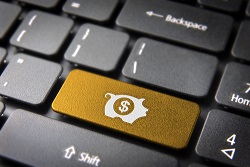On Nov. 11, United Technologies Corp. (NYSE: UTX) made the kind of announcement investors love to hear.
The defense and high-tech conglomerate said it was more than doubling the size of its current share-repurchase plan, adding another $6 billion to the $4 billion in stock it planned to buy back before 2016.
United Technologies is far from alone. In just the first six months of this year, U.S. firms spent more than a quarter of a trillion dollars on share buybacks.
And federal data shows that corporate buybacks, which have been rising for years now, are likely to grow even more between now and 2020.
The really good news for tech stocks is this: Technology companies make up the bulk of firms that are racing to repurchase their stock.
Today I'll show you an easy way to cash in on this buyback frenzy.
With it, you can beat the market by more than 30% over the next five years...
Rolling in Cash
As dramatic as the United Technologies announcement was, there was more enticing buyback news for investors.
Just one day before the UTX announcement, the German tech-industrial giant Siemens AG (OTCMKTS ADR: SIEGY) confirmed that it would buy back roughly $3.2 billion of its stock over the next three years. This was the second such program Siemens has adopted since 2013.
 Europe's largest engineering firm can afford to return so much wealth to its shareholders because it generates so much cash - $8.9 billion in 2014.
Europe's largest engineering firm can afford to return so much wealth to its shareholders because it generates so much cash - $8.9 billion in 2014.
That brings me to a key fact driving the current buyback boom. Companies in general, and U.S. firms in particular, are sitting on mountains of cash.
Market research firm FactSet said that at the end of the second quarter, the last period for full data, S&P 500 Index companies held a combined $1.43 trillion in cash on hand. That's the second-biggest cash reserve in the last decade and just a tad below the $1.45 trillion held in last year's fourth quarter.
Many firms are returning a portion of this cash to their shareholders, a move that benefits investors and companies alike.
By reducing the amount of shares out in the market, the companies instantly improve their earnings per share. In turn, that drives up the stock price, because equities trade at multiples of their earnings.
Investors benefit because with fewer shares in the open market, the value of the shares remaining in individuals' portfolios increases.
And if history is any guide, this cash-on-hand trend will only continue.
A 2013 study by the St. Louis Federal Reserve Bank found that U.S. nonfinancial firms have steadily increased their cash holdings going all the way back to 1980 (though they slipped during the financial crisis).
Economists surveyed offered a variety of reasons for the trend, such as building up a war chest for R&D and keeping the balance sheets clean of debt.
But one little-noticed fact really jumped out at me...
In turns out that tech and life sciences firms are building up more cash than firms in other sectors.
In a separate recent report, FactSet said share buybacks totaled $278 billion for the first six months of 2015. But during the second quarter, the last period for full data, the field was led by information technology firms, which had amassed $35.9 billion in cash, nearly 27% of the total.
The bottom line is this: Firms that are buying back stock can make attractive investments. But things aren't quite so simple. You still need to find the best companies.
Under the Hood
That's why I think tech investors ought to look at the PowerShares Buyback Achievers Fund (NYSE Arca: PKW).
With high tech and healthcare making up about 25% of this exchange-traded fund (ETF) and materials firms (many of which serve tech industries) accounting for another 6.6%, PKW is an excellent broad-based play on the current buyback frenzy.
That means we get the benefit of...
- Instant diversification across multiple industries, and...
- Access to high tech's huge cash haul.
As you might expect, PKW holds several big caps that are household names.
For instance, it owns aerospace giant Boeing Co. (NYSE: BA), which accounts for 5% of the fund's holdings. In December 2014, Boeing announced it will increase its share buyback program by $2 billion to $12 billion.
Apple Inc. (Nasdaq: AAPL) also accounts for nearly 5% of PKW's holdings. In its most recent fiscal quarter, the Silicon Valley legend repurchased some $14 billion of its stock.
Other well-known tech-related firms in the PKW roster include defense leaders General Dynamics Corp. (NYSE: GD) and Northrop Grumman Corp. (NYSE: NOC). The fund also is invested in International Business Machines Corp. (NYSE: IBM) and Yahoo Inc. (Nasdaq: YHOO).
But PKW also has an interesting mix of small- and mid-cap players. Take a look:
- Teradata Corp. (NYSE: TDC). Founded in 1979, the firm is the world leader in data warehousing and sells analytic tools customers need to make sense of that information. The company boasts 100% of the world's top telecoms and airlines and 80% of the top logistics firms as clients. On Aug. 20, Teradata added $500 million to its program, bringing the value of total share buybacks to $860 million.
- Motorola Solutions Inc. (NYSE: MSI). The firm just announced another $2 billion in buybacks following the roughly $8.7 billion it made over the past four years. That's a lot of shareholder return in a short period. The mobile communications and infrastructure firm only spun off from Motorola Inc. in January 2011. It's benefiting from increased sales of two-way radios, cellular communications, and networking gear for public agencies and first responders.
- The ADT Corp. (NYSE: ADT). This company is best known as a leader in home security. But in reality, it offers much more than that. The company has made use of advanced sensor technology as a sales hook. That's a big draw for ADT's home automation business and medical tech division, both of which are tied to smart mobile technology. In July, ADT said it would buy back up to $1 billion of its stock. That follows a $2 billion program it began three years ago.
- Corning Inc. (NYSE: GLW). It's one of the most important "Miracle Materials" firms in the world. The company has played a huge role in the success of the mobile revolution. Corning has already seen versions of its protective Gorilla Glass used in the screens of more than 3 billion electronic devices covering 40 major brands around the world. MarketsandMarkets is projecting that mobile device glass sales will soar some 285% by the end of the decade to $5.8 billion. In October, Corning announced a $10 billion buyback.
Running the Numbers
Trading at $47.34, PKW is a cost-effective way to play the share buyback boom. With this one move, you gain access to buybacks underway at more than 200 companies.
Besides tech, PKW is invested in finance, industrials, consumer products, and energy. So it's like holding a very specialized subset of the S&P 500.
[mmpazkzone name="in-story" network="9794" site="307044" id="137008" type="4"]
But over the past five years, PKW has greatly outperformed the broad market, returning 100.8% to investors on top of a respectable 1.1% dividend.
Over that same time frame, the S&P 500 had profits of 76% - meaning PKW beat the broad market by 32.6%.
This is the type of tech-related investment you can count on as a foundational play for the long haul.
Follow us on Twitter @moneymorning or like us on Facebook.
Cash In on Chinese Tech: Chinese tech stocks are out of favor on Wall Street, but Chinese e-commerce is booming. And there's an easy way to play the entire red-hot sector. For patient, long-term investors, it offers a lot of upside at an attractive price...
About the Author
Michael A. Robinson is a 36-year Silicon Valley veteran and one of the top tech and biotech financial analysts working today. That's because, as a consultant, senior adviser, and board member for Silicon Valley venture capital firms, Michael enjoys privileged access to pioneering CEOs, scientists, and high-profile players. And he brings this entire world of Silicon Valley "insiders" right to you...
- He was one of five people involved in early meetings for the $160 billion "cloud" computing phenomenon.
- He was there as Lee Iacocca and Roger Smith, the CEOs of Chrysler and GM, led the robotics revolution that saved the U.S. automotive industry.
- As cyber-security was becoming a focus of national security, Michael was with Dave DeWalt, the CEO of McAfee, right before Intel acquired his company for $7.8 billion.
This all means the entire world is constantly seeking Michael's insight.
In addition to being a regular guest and panelist on CNBC and Fox Business, he is also a Pulitzer Prize-nominated writer and reporter. His first book Overdrawn: The Bailout of American Savings warned people about the coming financial collapse - years before the word "bailout" became a household word.
Silicon Valley defense publications vie for his analysis. He's worked for Defense Media Network and Signal Magazine, as well as The New York Times, American Enterprise, and The Wall Street Journal.
And even with decades of experience, Michael believes there has never been a moment in time quite like this.
Right now, medical breakthroughs that once took years to develop are moving at a record speed. And that means we are going to see highly lucrative biotech investment opportunities come in fast and furious.
To help you navigate the historic opportunity in biotech, Michael launched the Bio-Tech Profit Alliance.
His other publications include: Strategic Tech Investor, The Nova-X Report, Bio-Technology Profit Alliance and Nexus-9 Network.



